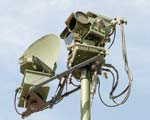
It's no surprise that for data industry leaders, when addressing the questions of physical access control, the overwhelming answer has been biometric technology, which provides a level of security beyond that of conventional card systems by verifying the identity of the person.
- By Jon Mooney
- Mar 03, 2010
A bill being considered by the New Hampshire legislature that would ban nearly all uses of biometrics is an inappropriate response to privacy concerns that would deprive residents of an important security technology, the Security Industry Association (SIA) has told state lawmakers.
Unisys Corp. will work with the government of Mexico and the Mexican communications company Axtel to develop an advanced national biometric identification system under a three-year contract valued at $50 million.
The City of Winter Park in Florida has selected DigitalPersona Inc., a provider of fingerprint identity and authentication solutions, to help address the two-factor authentication component of Criminal Justice Information System (CJIS) mandates.

Proponents of video analytics claim the technology can boost the productivity of security staff by alerting them to take action in the event an incident occurs according to predetermined rules. In theory, this enables fewer officers to oversee larger coverage areas by freeing them from perpetually watching an increasing number of video displays and make intelligent response decisions when security violations occur. And for many indoor surveillance applications, this is often the case.
- By John Romanowich
- Feb 03, 2010

When you think RFID in security, you automatically think access control. Access control badges are ubiquitous in enterprise environments for use at entrances and exits in virtually all industries. But there is more to RFID in security applications than going through doors.
- By Bill Nuffer, Leon Chlimper
- Feb 02, 2010
The “German House” at the Olympic Winter Games is the meeting point for athletes, advisers, officials, journalists and visitors from the worlds of business and politics around the German Olympic team. Secure and convenient access to the buildings is being provided by an access control system based on the contactless LEGIC advant technology.
IBM and Fujitsu Frontech North America Inc. recently announced a new security solution that integrates palm vein biometric technology from Fujitsu with IBM's single sign-on solution.
Sandata Technologies Inc., provider of information technology solutions to home healthcare and social services communities, announced recently the launch of its second generation speaker verification tool and selection of PerSay as its new technology partner to provide the voice biometric engine for Santrax.

In 2007, a customer of the AXA Group, a financial protection company, wanted to replace an existing strong authentication system with a smartcard- based solution to coincide with an end-user hardware refresh project. AXA Technology Services initially proposed its smartcard platform, and the customer was interested in extending it to support biometric authentication.
DigitalPersona Inc. recently announced that Bentley University has deployed the company's software on faculty and student laptops and PCs.
Gemalto recently announced that it has surpassed 25 million smart card-based identity credentials shipped to the U.S. federal government.
Looking ahead to 2010, Unisys predicts that government and commercial organizations will take a more proactive approach to security, implementing new measures to verify identity and protect confidential information. Financial institutions and defense agencies will lead the charge, with ports and other organizations quickly following.

There is no question that advancements in video are continually revolutionizing the security industry. New capabilities emerge and, subsequently, the scope of what is possible grows. The implications of this trend can be seen in surveillance, reconnaissance, identity verification, information management and data dissemination.
- By John Bradburn, Mark Clifton
- Dec 01, 2009
With concerns growing over the incidence of bank card fraud and identity theft, a majority of people globally would accept biometric authentication to verify their identities, according to recent research from Unisys Corp.
SCM Microsystems Inc., a provider of solutions for secure access, secure identity and secure exchange, and LEGIC Identsystems, a manufacturer of contactless smart card technology for personal identification, announced recently that they have formed a strategic partnership to create new products that support integrated physical and logical access.

A new report by computer scientists at the National Institute of Standards and Technology demonstrates that iris recognition algorithms can maintain their accuracy and interoperability with compact images, affirming their potential for large-scale identity management applications.
Government policy makers and healthcare stakeholders looking to establish electronic medical records (EMRs) to improve the U.S. healthcare system should look first to defining the identity management infrastructure for securely identifying patients, medical providers and anyone else handling the records, stated the Smart Card Alliance Healthcare and Identity Councils in a position paper issued recently.
Naval Air Station Fallon has implemented the RAPIDGate Program to increase security and streamline access for the thousands of vendors, suppliers, service providers and contractors who access the installation.
Fujitsu Frontech North America Inc. recently announced that Bates County Memorial Hospital in Butler, Mo. is using the Fujitsu PalmSecure palm vein authentication solution for its time and attendance system.